
MAY CONTAIN NUTS

Search Shorpy
SHORPY ART

Framed or unframed, desk size to sofa size, printed by us in Arizona and Alabama since 2007. Explore now.
Join and Share
Ad-Free Shorpy
Shorpy is funded by you. Patreon contributors get an ad-free experience.
Learn more.

Recent comments
- Baldwin 62303
- Baldwin VO-1000
- Cold
- No expense spared
- Tough Guys
- Lost in Toyland
- And without gloves
- If I were a blindfolded time traveler
- Smoke Consumer Also Cooks
- Oh that stove!
- Possibly still there?
- What?!?
- $100 Reward
- Freeze Frame
- Texas Flyer wanted
- Just a Year Too Soon
- WWII -- Replacing men with women at the railroad crossing.
- Yes, Icing
- You kids drive me nuts!
- NOT An Easy Job
- I wonder
- Just add window boxes
- Icing Platform?
- Indiana Harbor Belt abides
- Freezing haze
- Corrections (for those who care)
- C&NW at Nelson
- Fallen Flags
- A dangerous job made worse
- Water Stop
Member Photos
The Shorpy
Print Emporium
Print Emporium
Search Shorpy
Search results -- 30 results per page
- Streets of San Francisco: 1957
- ... my youth. I'm going to share this photo with my old-time San Francisco friends who complain about the lack of parking in San Francisco ... Posted by rsyung - 07/23/2014 - 1:01pm -
![Streets of San Francisco: 1957 UPDATE: By amazing coincidence, the photographer here (the late father of Shorpy member rsyung) seems to have stumbled upon a shooting location for the Alfred Hitchcock thriller "Vertigo," with the same cars lined up along the curb as in a scene from the movie. Scroll down to the comments for details. -- Dave
Taken by my dad in August, 1957. Bay Bridge in the background. I'm sure someone with an intimate knowledge of "The City" and / or Google maps will figure out which street this is. Kodachrome slide, Contax camera. View full size.
Curb appealGreat shot of the City from my youth. I'm going to share this photo with my old-time San Francisco friends who complain about the lack of parking in San Francisco today.
("Back in the '50s and '60s there used to be PLENTY of parking in this town ...")
VertigoThis picture had to be taken the same day as Vertigo was filming. The shadows give us a clue that there was some time difference between the photo and the screen grab (the first car on the right is the only car that I see that is different). It's uncanny to see the same cars in the same spots and the same angles as in the movie screen grab! Awesome!
SF Street1100 block of Clay Street.
View Larger Map
'53 PlymouthFirst full steel bodied production station wagon.
Screen grab from Hitchcock's VertigoLooks like Alfred liked this view of the bridge. He used the same intersection in the "Vertigo," where Jimmy Stewart was following Kim Novak about 54 minutes into the film. He must have seen the film or been a location scout. Pretty amazing coincidence.
UPDATE - Had to be filming the Vertigo scene!Man, I'm really off my game here. I just noticed that the screengrab I took from the movie has the same exact cars parked in the street!
What's behind us?When I clicked on the full-size view of this photo I instinctively tried to grab it with the cursor and turn the scene around. It did not work. Google Street View didn't work very well in 1957, I guess.
Had no clueI was floored to see the Vertigo screen grab. My parents and my older sister were visiting San Francisco and Monterey that August of '57, and I had no idea my dad snapped what turns out to be the exact spot Vertigo filmed a scene in, and probably the same day! And shame on me, because I am a big Hitchcock fan to boot! Pure coincidence, my Shorpy friends. My guess is that those were picture cars lined up along the curb for a few days, as continuity would have to be preserved and these scenes might take up to a few days to film ... unless someone has the production schedule for that week!
--Ron Yungul
[What kind of car were Mom and Dad driving? Wouldn't it be something if you could spot them in "Vertigo." - Dave]
Who woulda thunk?A person in 1957 could never have dreamed that the new "vintage" cars casually parked along the street would one day be worth a small fortune. The car shadows seem the same to me. I wonder if rsyung's father was working with, or watching, the Vertigo film crew and took a snapshot of his own.
Filming began on Sept. 13, 1957According to Vertigo: The Making of a Hitchcock Classic: Special Edition.
Whereas this site claims Sept. 30 to Oct. 15 and shows locations on a map.
[And now we seem to have pushed filming back to August, at least for the "driving" footage. Which makes sense as far as the cars go. I recall seeing only one 1958 model in the movie, a Chevrolet. - Dave]
55 Chrysler New YorkerDustybroome's hood shot looks like my 55 Chrysler New Yorker from the fender to the hood ornament!
[As anyone who's seen "Vertigo" could tell you, that's the hood of Jimmy Stewart's 1956 DeSoto Firedome, which has a major supporting role. - Dave]
Maybe a mistakeIsn't it possible that this is a shot from the movie, and it was mistaken for a photo taken by someone else. Seems likely, given that it's almost identical to the movie shot.
[And somehow made its way into a box of Ron's family photos as a 35mm Kodachrome slide? - Dave]
And now the PlymouthHey buddy. Your taillight's out!
Second unit filming completed August 1957According to the link provided by JohnnyYuma to Hitchcock Zone's "Vertigo" article:
Whilst the formal production date slipped due to the delays, a second unit team, headed by assistant director Daniel McCauley, began filming backgrounds (for use in rear projection scenes in the studio), establishing shots of the city and various street scenes, along with test footage of the main filming locations. McCauley returned to San Francisco in August 1957 to film the remaining second unit footage and the backgrounds for use in the film's many driving scenes.
My emphasis. That settles it for me -- rsyung's dad did take his photo while the street was in use by McCauley's 2nd unit crew.
Have I mentioned... what a sensational site this is? I never cease to admire the diligent research done by readers here. This particular photo, with its incredible coincidence of timing, is the best example I've seen yet of the wonders of Shorpy.
And sure, I'm biased as resident of the Bay Area, but still -- this is a fantastic thread. Kudos to all involved, especially rsyung's dad!
Oh yeah, and that Hitchcock guy. ;-)
More info re: Streets of San FranciscoMy mom, in her late 80s, has no recollection of that particular day. My parents were driving a two-tone sky blue Buick with dark blue hard top (I'm not a car buff so I can't be more specific, although they bought it in '55). Regarding the info about second unit photography, my guess is it's all the more remarkable as they probably were only shooting for that one day on Clay Street, and those cars were probably not picture cars, meaning the window of time was even narrower for my dad and family to be there at just the right time and place.
VertigoI get vertigo just trying to comprehend the odds of this happening.
The Shadows KnowI compared shadow lengths between the two photos by measuring the ratios of three arbitrary (other than being easily measurable) points on three cars (number of pixels of shadow width versus car height) and came up with 0.54 vs. 0.52, 0.56 vs. 0.51, and 0.53 vs. 0.48, with the movie screenshot denoted first in each pair of numbers. We would need a statistician to tell us if they are significantly different, but this seems to indicate that the shadows are longer in the movie still, meaning that the rsyung photo was taken first. What an incredible coincidence it would be if he had taken the photo a short time before the film crew arrived, unaware of their eventual presence.
Elevation and azimuthWith this website : http://www.esrl.noaa.gov/gmd/grad/solcalc/, you can view the orientation of the sunlight at any given time, on a certain date.
If you choose the Clay street in San Francisco in August 1957, it shows you that the sunrise axis was almost parallel to that street. Then the sun started its arc on the left of the picture, and set a little bit on the right, behind the photographer.
Given the shadows, the sun is almost perpendicular to the street, a bit forward. Which means that the shot was taken between noon and 12:30 (DST applied by law since 1954).
There is not a lot of differences between the shadows of both shots. It seems to me that they're a little bit longer in the rsyung picture (see for example the roof shadow from the red '55 Chevy on the right), meaning that it was probably taken earlier than the Vertigo shot.
With the data given on the website (solar elevation and azimuth), and with an HD version of the Vertigo shot, one could calculate the hour at which each picture was taken.
But I'll bet there is half an hour to an hour, at the most, between both shots.
PontiacThe only significant difference between the two photos in question . . . it appears that a 1956 Pontiac is behind the 55 Chevy on the right side of the street in one of the photos, while a 55 Ford station wagon occupies that position in the other pic.
(ShorpyBlog, Member Gallery)](https://www.shorpy.com/files/images/SFAug57d.thumbnail.jpg)
- 1904 Tap Room, San Francisco, California
- A San Francisco taproom in 1904. View full size.
Looks so familiar That ... The place you guys are thinking of..... is called the San Francisco Brewing Co. This however is not that place. One, the bar is on ... Posted by Joe - 09/22/2011 - 11:34pm -
![1904 Tap Room, San Francisco, California A San Francisco taproom in 1904. View full size.
Looks so familiarThat room and bar look so familiar. I'd swear that place was still standing, still pouring beer in 1986. It was a bar in North Beach about a block from the City Lights bookstore. Best Anchor Steam I ever had.
Anyone know if this place is still standing?
SpittoonsThose spittoons are pretty darn disgusting. Wonder how often they get clean? Very interesting photograph.
Pepsi Cola hits the spotWhen you look at this picture in full size you discover that the pictures on that little bump-out from the bar are actually advertising posters for Pepsi Cola. At that point the company would have been about two years old. As for the tap room, it would be interesting to know the location but I'd be willing to bet that this particular building wouldn't have been standing three years later.
LocationMy guess as to location is that it was in the old produce district, which is now where the embarcadero center and Hyatt Regency are. As far as its survival, the chances are very slim. The bar itself may have been saved and might be residing in a different place, but, as Brent pointed out in his post, almost everything east of Van Ness burned after the 1906 earthquake.
Rob
Looks so familiarPerhaps you are thinking of Tosca across the street from City Lights? Think darker, smokier, and lower ceiling. It's still there but this ain't it.
The place you guys are thinking of.....is called the San Francisco Brewing Co. This however is not that place. One, the bar is on the wrong side of the room relative to the doorway. And two, there is a trough under the brass rail at SFBC. Story is, that when the place got full with patrons back in the day, no one would want to lose their place at the bar. So, if you had to go, you just unbuttoned the fly and let er fly. I think it's a bit of a tale, and was more likely a place to hawk loogies of tobacco. Or both.
SanitationI agree with jbart. Those goboons really need some extra attention.
Slot machine and ?I believe the large machine at the right of the bar is a Puritan Bell slot machine. I can't figure out the purpose of the small machine between the slot machine and the cigar case. Has anyone identified that device?
[Allow me. It's a "Yankee" cigar cutter. - Dave]
(ShorpyBlog, Member Gallery, Eateries & Bars)](https://www.shorpy.com/files/images/lastscan.thumbnail.jpg)
- San Francisco: 1906
- "The Burning of the Call." The San Francisco Call newspaper building in flames after the April 18, 1906 ... at the Southwest corner of Third and Market Streets in San Francisco.
Call Building I had an office in that building for a ... Posted by Dave - 08/23/2011 - 1:08pm -
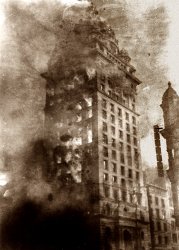
- San Francisco: 1927
- "San Francisco views, 1927." On Pine Street, looking east at the 32-story Russ ... this photograph was taken, virtually the entire city of San Francisco was in ruins after the Earthquake/Fire of 1906.
21 years ... Posted by Dave - 01/01/2014 - 4:26pm -
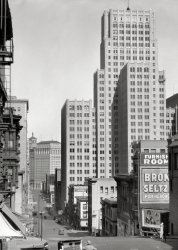
- San Francisco Briscoe: 1919
- San Francisco circa 1919. "Briscoe auto at Lands End." Latest entry in the Shorpy ... The Briscoe couple were parked just above China Beach in San Francisco's ritzy Sea Cliff neighborhood. Courtesy of Google Earth, we see ... Posted by Dave - 01/11/2016 - 11:06pm -
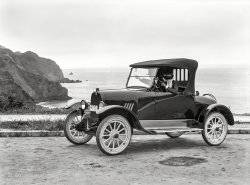
- Sidewalks Are for Sissies: 1920
- San Francisco circa 1920. "Franklin car ascending steep grade." Bonus points if you ... your peepers on that paint job!
From the Chronicle San Francisco Chronicle, Aug 29, 1920; pg. A7
City Driving Art In Itself
... Posted by Dave - 09/16/2014 - 9:17am -
![Sidewalks Are for Sissies: 1920 San Francisco circa 1920. "Franklin car ascending steep grade." Bonus points if you can Street View this. 8.5 x 6.5 negative by Christopher Helin. View full size.
Forget the locationFeast your peepers on that paint job!
From the ChronicleSan Francisco Chronicle, Aug 29, 1920; pg. A7
City Driving Art In Itself
Driving in Country Far Different in Method, Expert Holds
Franklin Car Proves Power
The Franklin car has a lot of power, as will be proven by the accompanying photo, which shows the new touring model speeding up a difficult and roadless grade.
Article does not mention the location of the hill.
Vallejo StreetThe 900 block of Vallejo Street.
View Larger Map
Nice upgradeI don't know if it's unusual or not in the City, but I do find the squeezing in of a garage there rather ingenious.
[Very common in older San Francisco homes. -tterrace]
$an Francisco!Those beautiful old stacked homes in San Francisco now go for millions!
About those Bonus PointsI think tterrace deserves them for fast work and a great view of the lovely houses.
[Bonus points are included with the Shorpy Inc. Christmas bonus, as per corporate policy, redeemable in turkey or ham. - Dave]
Thanks Dave. Does that come with cranberry sauce?
Blood, Sweat and TearsWhat goes up ... must come down.
(The Gallery, Cars, Trucks, Buses, Chris Helin, San Francisco)](https://www.shorpy.com/files/images/SHORPY-GN-Helin-Franklin-2.thumbnail.jpg)
- San Francisco Ferry: 1955
- My father took this picture on a trip to Northern California in 1955. He worked as an engineer for Riverside County and was visiting various engineering projects. View full size.
Gas Works Nice shot. The large gas tank near Fort Mason ... Posted by motobean - 02/21/2014 - 8:21pm -
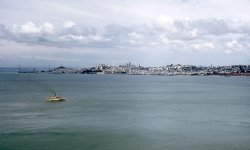
- 428 San Francisco Portland 275
- ... right, since I-5 and 99 split north of Eugene.
The San Francisco route probably took the old HIghway 101 down the coast rather than ... Posted by Dave - 08/08/2012 - 8:14pm -
![428 San Francisco Portland 275 U.S. 99 in Josephine County, Oregon. August 1939. Sign in service station window advertising for hop pickers three weeks before opening season. View full size. Photograph by Dorothea Lange. What city is this? [Answer: Grants Pass]
SFO-PDXI believe in the Full-Size I can make out the words "City of Grants Pass" on the base of the street lamp. This would make sense as 99 (not a US highway anymore) passes through the city and the mileage makes sense.
Grants PassBingo. It says BUILT BY GRANTS PASS IRON AND STEEL. Good work!
I agree with the commenterI agree with the commenter below. I can't read the lightpost base, but it's about 70 miles to Roseburg and 30 miles to Medford from Grants Pass, and I-5 was built along the old Highway 99 in that part of the state. The Portland distance is probably less right, since I-5 and 99 split north of Eugene.
The San Francisco route probably took the old HIghway 101 down the coast rather than 99, which would explain the extra mileage I didn't expect. The inland route ought to be 375-385 miles, not the 435 miles the sign says. Highway 135, which connects Grants Pass to Crescent City, would've been pretty new then.
Chet EideFor what it's worth, a death records search shows a Charles Eide born in 1920 and died 2001 in Lebanon, Oregon. Which is not far from the old Route 99. Up near Corvallis. Maybe the son of Chet?
Definitely Grants PassThe movie poster says "Rogue" and a quick Google search shows the Rogue Theatre is still a going concern in Grants Pass.
Another clue... would be the sign that says GRANTS PASS BAKERY. Doy. (Not legible in the full size jpeg but I should have looked a little closer at the hi-res tiff.)
Grants PassI should have read through the other comments before I started digging for info. :)
Grants PassOur son just emailed this link to me. The City Market in the picture was owned by my Grandfather. My Uncle that worked there is still living. He is an active 97 year old that refuses to grow old. If someone goes to the Wayside Inn at Alamo Lake, Arizona, he has many stories of the Grants Pass area, life in general, and a "few" biased opinions. I can still recall playing in the building during the early 1950's, while my Dad worked there.
Lebanon and CorvallisLebanon is well east of old hwy 99E, almost to the foothills of the Cascades. Corvallis is on the west side of the Willamette valley on old hwy 99W
HighwaysIt is Hwy 199 the connects Grants Pass with Crescent City California. I've driven it many times. The mileage is probably as near correct as any of the mileage signs in those days. The freeways shortened travel considerably. During WWII the highway over Mt. Sexton, just north of Grants Pass was rebuilt, almost to today's freeway standards because the army convoys couldn't handle the hairpin curves. I think the same thing happened to the Siskiyou pass. Prior to the freeway the highway passed through 32 towns between Portland and Medford using old 99E, a few less if you went 99W.
Prior to construction of 505 in California you had to go clear into Sacramento to get to San Francisco. I've driven all of these highways many times.
Tarzan Movie Poster in WindowFor those interested in such things:
http://www.imdb.com/title/tt0032007/
Grants PassThis is Sixth Street looking down G Street. All the shops still have businesses in them. The structure on the right is not there anymore. That corner has a small building for the Grants Pass Chamber of Commerce.
(The Gallery, Dorothea Lange, On the Road)](https://www.shorpy.com/files/images/8b34278u.thumbnail.jpg)
- Fenders Fixed: 1920
- San Francisco circa 1920. "Day-Elder truck." Latest entry on the Shorpy List of ... remains, superficially altered a bit.
San Francisco Sidewall Again On the right front, from being jammed against ... Posted by Dave - 04/27/2016 - 1:55pm -
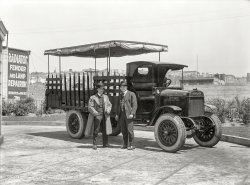
- Yuen Hing & Co.: 1921
- "REO Speedwagon grocery truck, San Francisco, 1921." Compare with our previous Speedwagon . Glass negative by ... size.
Musically speaking, We're on Grant Avenue, San Francisco, California, USA.
[Most interesting. I wonder how one would ... Posted by Dave - 05/01/2015 - 2:05pm -
![Yuen Hing & Co.: 1921 "REO Speedwagon grocery truck, San Francisco, 1921." Compare with our previous Speedwagon. Glass negative by Christopher Helin. View full size.
Musically speaking,We're on Grant Avenue, San Francisco, California, USA.
[Most interesting. I wonder how one would travel there. - Dave]
[Ideally in a trolley, but you have to settle for a cable car. -tterrace]
Weather-beatenLots of mud splatters. Could be from riding the storm out.
Can't fight this feeling anymore...I like this truck.
Stopping distanceI wonder what the stopping distance was for one of these trucks when fully loaded, using rear wheel only mechanical brakes, on a steep San Francisco hill. Lots of smoke, then right into the Bay!
Having Learned To Drive in San FranciscoOne learned quickly the streets that were too steep to comfortably drive. Trucks, unless they were delivering locally, were usually banned from streets like Divisadero (seen in the movie "Bullit"). These delivery trucks usually had a "granny gear" which was a very low 1st gear and would hold the vehicle to a crawl when descending steep hills. Brakes were not usually needed.
Chinatown Telephone ExchangeOn the side door of the truck you can see the letters "PHONE CHINA" and the beginning of a numeral. San Francisco's Chinatown had its own telephone exchange from 1887 until the 1940s when dial phones replaced the switchboard operators. How it all worked is explained here.
A Hundred Million Miracles"Grant Avenue San Francisco" was in Rodgers and Hammerstein's Broadway hit "Flower Drum Song" from 1958. The film version released in 1961 was nominated for 11 Academy Awards.
Western street with Eastern manners,
Tall pagodas and golden banners,
Throw their shadows through the lantern glow.
You can shop for precious jade
or teakwood tables or silk brocade
Or see a bold and brassy night club show,
On the most exciting thoroughfare I know --
Grant Avenue, San Francisco,
California, U.S.A.
Looks down from Chinatown
Over a foggy bay.
You travel there in a trolley,
In a trolley up you climb,
Dong! Dong! You're in Hong Kong,
Having yourself a time.
You can eat, if you are in the mood,
Shark-fin soup, bean cake fish.
The girl who serves you all your food
Is another tasty dish!
You know that
You can't have a new way of living
Till you're living all the way
On Grant Avenue --Where is that?--
San Francisco, That's where's that!
California, U.S.A.!
(The Gallery, Cars, Trucks, Buses, Chris Helin, San Francisco, Stores & Markets)](https://www.shorpy.com/files/images/SHORPY-326-01.thumbnail.jpg)
- Close Friends: 1920
- San Francisco circa 1920. "Oldsmobile coupe on Gough Street at Lafayette Park." ... prepared. I hope they don't get a flat.
Street of San Francisco This was too easy.
View Larger Map
Looks ... Posted by Dave - 10/15/2014 - 12:05pm -
![Close Friends: 1920 San Francisco circa 1920. "Oldsmobile coupe on Gough Street at Lafayette Park." Seats three! 5x7 glass negative by Christopher Helin. View full size.
They certainly aren't well prepared.I hope they don't get a flat.
Street of San FranciscoThis was too easy.
View Larger Map
Looks Brand NewNo spare tire on the rim and overall dapper look of this car suggests it is brand new.
[That's the reason the photo was taken, Christopher Helin being the travel and automotive writer for the San Francisco Examiner. -tterrace]
Winged FeetI've never before heard of the Goodyear Wingfoot tires that appear on this Olds; however, if I had a set of tires so grandly named, I'm sure I'd be far too confident to fuss about the lack of a spare.
Brief (and dry) bio of Christopher HelinSomeone commented about how the woman could have been the photographer's wife over on Facebook, which prompted me to see what I could find on the man himself, purely out of curiosity.
I first located him in 1910 in the US Census, living in Minneapolis, 23 years old with wife Alida, sister Katherine and parents Andrew and Katherine. His occupation was listed as Salesman, and his father's, "Sawer / Saw Mill."
He appears in the Minneapolis city directories right up to 1919 where he's listed as "Advertising solicitor, Minneapolis Journal."
He next appears in the 1920 Census, living in an apartment at 400 Stanyan Street in San Francisco with his wife Alida and children Francis (age 8), Richard (4 10/12 - never saw them add months to children over 1 before!) and Geraldine (age 1 2/12). His occupation is now "Fore Man, Saw Mill." Everyone is listed as being born in Minnesota. My only guess is he relocated to San Francisco and grabbed the first job he could while submitting articles to get a foot in the door with the Examiner.
By the time he appears in the 1921 San Francisco city directory, he's relocated to 1044 Lake Street (his occupation isn't shown, but he had already had automotive related articles in the Examiner by at least October of 1920). By 1922 he's listed as a "solicitor" for the San Francisco Examiner, and residing in Burlingame.
By 1930, he's become an editor for the newspaper (though in 1931 the city directory still has him as an advertising solicitor), and he had added a fourth child, Patricia (age 9), and was living at a home he owned at 1132 Cortez Avenue in Burlingame.
He does appear in a few articles in the late 1920s into the 1930s as having run (unsuccessfully, I believe) for local public office.
One of the articles did have his photo in it, which I'll get to later, as its kind of interesting.
By 1940 he'd become an insurance salesman (a change of occupation from the mid-1930s going by the city directory listings), and was still living at the same address.
Chris J. Helin died in February of 1964, and his widow Alida is listed in 1965 at the same address. By 1971 she'd moved to an apartment complex at 10 De Sabla Road (her son and presumably grandson were living in town, one worked for GE, the other as a salesman for some place called "Russells"). She died in 1977.
Getting back to his photo from the late 1920s, his features immediately jumped out at me - Mr. Chris J. Helin is the glowering gentleman in the middle of the seat in this photo.
[Bravo! - Dave]
Re: tterrace's "too easy"Not quite easy enough -- if you want the exact view, you have to click forward two times from the spot you chose.
Nice to see that even though the retaining wall seems to have been stripped of some of its ornamentation since 1920, the concrete post with the rounded top is still identical. The car is basically where the black SUVish vehicle is in the Google Maps post.
[That car in the Google view is directly opposite the house with the red bricks that's farther up the street at the extreme right edge of the 1920 shot. -tterrace]
Still Used TodayThe Goodyear Winged Foot has been their trademark since shortly after the company began. Here's a recent sign.
Motion DampersExternal contracting brakes on the rear axle,
and a front axle devoid of brakes.
In San Francisco.
There's some real entertainment potential.
Christopher Helin was my grandfatherChris was my father's father. He was in the first graduating class of 1903 from De LaSalle HS in Minneapolis. He started work with the local Tribune newspaper and worked his way into a position as assistant editor of the auto section. William Randolph Hearst personally moved him and his new family to San Francisco in 1916 and made him Editor of the SF Examiner's Auto Section. In order to help sell cars (and thereby sell advertising) in a city already having a world class transportation system, he would test drive new cars during a substantial tour outside the City thereby creating a desire to travel in a similar manner which only an automobile could provide. To view an annual collection of these Sunday Supplements click here.
He left the SF Examiner in the early 1930's when the markets crashed and auto sales became next to impossible.
The woman on the left is his sister, Katie Helin. The man on the right is Howard Meacham, one of his two assistant editors.
(The Gallery, Cars, Trucks, Buses, Chris Helin, San Francisco)](https://www.shorpy.com/files/images/SHORPY-141015-0003.thumbnail.jpg)
- Smoking Rubble: 1906
- "Nob Hill from roof of Ferry Post Office." San Francisco after the earthquake and fire of April 18, 1906. Detroit Publishing ... elevator, and the gnarled old guy who operated it.
San Francisco San Francisco is such a fascinating city to me because as I ... Posted by Dave - 07/19/2012 - 4:39pm -
![Smoking Rubble: 1906 "Nob Hill from roof of Ferry Post Office." San Francisco after the earthquake and fire of April 18, 1906. Detroit Publishing glass negative. View full size.
GranddadMy grandfather (who died a year before I was born) claimed he was there for the earthquake, he was quite the wanderer in his early years. I wonder if he saw Caruso?
HighlanderThe Fairmont is still there. You can't see it from this distance but all of the windows broke from the heat. When the quake struck the hotel was still two weeks from opening; the furnishings had been delivered but not yet arranged, perhaps sparing the place from the fiery, utter destruction that the neighboring hotels met with.
She finally opened a year to the day after the quake.
Whittell BuildingAbout one quarter away from the left in the distance is the skeleton of a building with a low-peaked roof. It's not an earthquake victim, but the Whittell Building, under construction at the time. Local architects actually designed it to be seismically resistant; construction was completed and it stands to this day on Union Square. My Uncle Frank had his lapidary business in it from the 1920s until he retired. I remember riding up to it in the rickety cage elevator, and the gnarled old guy who operated it.
San FranciscoSan Francisco is such a fascinating city to me because as I rode the cable cars up and down its steep hilly streets, I wondered, "Who in the world thought this was a good place to build a city?"
I simply couldn't imagine being one of the first to enter this land and thinking it was a good idea to build a house and neighborhood on a street with a 60 degree incline. Surely they could have gone out just a bit farther and found flatter land.
Add to it this earthquake, and I marvel that they didn't just throw up their hands and find flatter land to settle in.
Glad they didn't though; SF is a gem among gems.
[Like most coastal cities, SF is where it is because of maritime geography, not topography -- an anchorage at the mouth of a sheltered bay. - Dave]
Rubble rubble everywhereVast quantities of rubble were dumped along San Francisco's bay shore from Fisherman's Wharf to south of today's AT&T baseball park. The motive power? Mules, horses, and trains that ran on tracks laid temporarily atop city streets especially for the purpose. (According to the Library of Congress, nearly 17,000 horses were worked to death in the process. No stats for the poor mules.)
Historians agree, though, that little if any earthquake rubble was dumped in the modern Marina District. The reason? The undeveloped area (then called Harbor View) was too far from the destroyed downtown areas being cleared to be useful. Also, the intervening hills between downtown and Harbor View prohibiting laying railroad track.
Shaky FoundationsI have read that the Marina District which was heavily damaged in the last quake was built on fill from this quake. Kind of ironic when you think about it.
Re: Too MuchIt is a good thing everyone did not feel such despair. They got up, dusted themselves off and went to work to rebuild the city.
Hotel Fairmont Looks like the hotel off in the distance. The outside of the building survived relatively unscathed, but the interior suffered fire damage.
This is one of the most interesting images of the aftermath I've seen. I get a real sense of what it must have been like to see and be amongst the destruction. So much to clean up before the rebuilding begins.
Caruso's Last StandAnd after being awakened by the tremor, Caruso vowed never to return to San Francisco, a vow which he kept. As for the Fairmont Hotel, it was nearly complete at the time of the earthquake and fire, and its opening was delayed until the next year.
At the far left is another landmark of the time, the Call-Spreckels Building, home of the San Francisco Call newspaper.
Awful DamageWith every one of these I see on Shorpy, all I can think of is Hiroshima or Berlin circa 1945. Did you know that Enrico Caruso was in town at the time?
Too muchWhere and how do you even begin to clean up the debris? It's all just so overwhelming.
London on FriscoJack London on the quake:
Day was trying to dawn through the smoke-pall. A sickly light was creeping over the face of things. Once only the sun broke through the smoke-pall, blood-red, and showing quarter its usual size. The smoke-pall itself, viewed from beneath, was a rose color that pulsed and fluttered with lavender shades Then it turned to mauve and yellow and dun. There was no sun. And so dawned the second day on stricken San Francisco.
(The Gallery, DPC, Fires, Floods etc., San Francisco)](https://www.shorpy.com/files/images/4a13263a.thumbnail.jpg)
- Streets of San Francisco, Cont'd
- Chinatown, San Francisco, August 1957. Taken on the same visit as the drive down the ... Posted by rsyung - 07/28/2014 - 3:36pm -
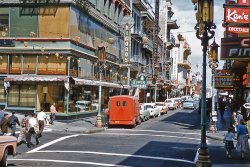
- San Francisco: 1959
- First Unitarian Church at 1187 Franklin Street in San Francisco. Built in 1889, it seems to have survived the 1906 earthquake and ... Posted by Rute Boye - 08/13/2012 - 10:08am -
![San Francisco: 1959 First Unitarian Church at 1187 Franklin Street in San Francisco. Built in 1889, it seems to have survived the 1906 earthquake and fire nicely. Anscochrome taken by my father in August 1959. View full size.
Buick SpecialA nice 1954 Buick Special 2-door hardtop right in front, then a late '40s Chrysler product, a '57 Chevy station wagon, and the back end of a '59 Ford. Looks like a '51-'52 chevy 2-door post going by in the background.
Before all GM products looked alikeWhen looking at pictures of this vintage, one does not have to be an expert on automobiles to be able to instantly identify a Buick, for obvious reasons.
Thomas Starr KingBeyond the red car (Buick?) in the grassy spot is the burial place of the Reverend Thomas Starr King, Universalist minister of First Unitarian Church, and one of the most influential and significant personalities of the Civil War period. He has often given credit for keeping California in the Union; he raised huge sums for the Sanitary Commission (some Sanitary Commission photos somewhere on Shorpy)and died young.
Until recently his statue was in Statuary Hall of the US Capitol, along with Father Serra, representing California. His portrait can be seen in the California Capitol.
When I was in 3rd grade I attended Thomas Starr King Elementary School in Long Beach, California.
AnscochromeAnsco sold a 500 a.s.a. film that I tried out on R&R in Hong Kong in the late sixties. A bit grainy but it had a lovely pastel-like color. I quite liked it and somewhere I have a few slides, that survived many a move, to this day.
Still going strongHere's a view of the same building today. I bet it was a job to clean off all that ivy!
A Casualty, I'm Bettin'I think there was more to the steeple in 1905.
[And you'd win. Here it is shortly after the earthquake, courtesy the Detroit Publishing Co. - tterrace]
(ShorpyBlog, Member Gallery)](https://www.shorpy.com/files/images/1stUnitarianChSF1959_0.thumbnail.jpg)
- San Francisco Flower Power c.1958
- Another slide from San Francisco, where I grew up. This photo was taken on Sutter Street circa 1958. ... surprisingly vivid colors! They brought Flower Power to San Francisco well before the hippies arrived! View full size.
... Posted by Rute Boye - 07/20/2012 - 10:04pm -
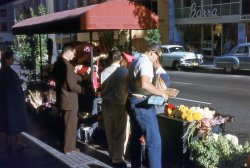
- San Francisco: Circa 1970
- Second Street looking NW toward Market Street, which seems to still be coping with BART construction. Far as I know, 1970 is as good a guess as any. 4x5 Ektachrome, 180 mm Symmar and a polarizer.
(ShorpyBlog, Member Gallery) ... Posted by Timz - 05/28/2022 - 4:18pm -
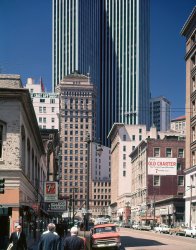
- San Francisco Owl Drugs
- San Francisco Ave & Market St. View full size.
GG & Taylor This ... Posted by Nuclear Art - 09/20/2011 - 1:13pm -
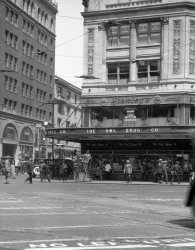
- Streets of San Francisco, Part III
- ... We have mapped out this and a few other photos from Ron of San Francisco in our archive (with his permission). Please explore and leave ... Posted by rsyung - 08/08/2014 - 7:32pm -
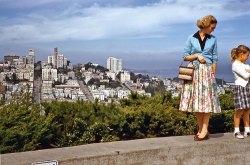
- San Francisco warehouse, 1973
- ... early 1973 at corner of Lombard and Battery Streets along San Francisco's Embarcadero. Camera: 4x5 Speed Graphic. The brick building with ... Posted by Histry2 - 05/18/2012 - 9:49pm -
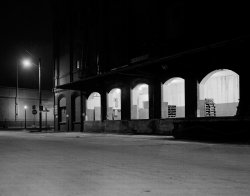
- Young San Francisco Girl
- Taken of my mother Gladys Wagner in San Francisco around 1905. View full size.
(ShorpyBlog, Member Gallery) ... Posted by chiliangel - 12/26/2011 - 11:36am -
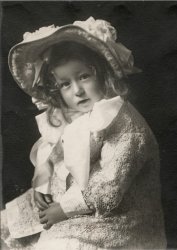
- Essex Ascending: 1930
- San Francisco, 1930. "Essex Super Six climbing Webster Street hill." Latest display ... in the rumble seat.... once. I never did.
Hills of San Francisco All of these automobile photos appear to be trying to sell us ... Posted by Dave - 07/29/2015 - 4:00am -
![Essex Ascending: 1930 San Francisco, 1930. "Essex Super Six climbing Webster Street hill." Latest display in the Shorpy Diorama of Discontinued Dreadnoughts. 5x7 inch glass negative by automotive impresario Christopher Helin. View full size.
She had an EssexPolly Archer, my grandmother's best friend, had a 1926 Essex that was her very first car (purchased in the early/mid 1930s) that she never got rid of. She had it until she died in the late 1980s.
This is obviously a VERY upgraded car, since hers still had Kerosene headlamps. Many is the time that I remember "Aunt Polly" taking us around the block in that car in the 1970s and 1980s after one of her Luau BBQs; we'd put on ancient 1920s hats and motor around Portsmouth, Virginia on lazy Saturday evenings.
Even though it was a full sedan, it STILL had a rumble seat, instead of a trunk. My older sister got to ride in the rumble seat.... once. I never did.
Hills of San FranciscoAll of these automobile photos appear to be trying to sell us on the car being able to climb the hills in San Francisco. That's nice and all, but I would be impressed when I see someone start off on that incline without choking down the car or burning up the clutch. I think you need a Studebaker "Hill Holder" to handle that.
Bill Cosby is poison now, but his old routine about driving in San Francisco was a hoot. https://youtu.be/oOmayx2JBs8
Cosby: Well, I don't want to let [the guy behind me] know I can't drive, so I say "Come around, idiot, come around!" but he can't hear me because he's busy telling the guy behind him, "Come around, idiot, come around!"
Titanic!I learned to drive a car on the streets of San Francisco (most of which are more vertical than flat) but I am so glad I didn't have to learn in one of these locomotives!
Note to Engineering DepartmentJake,
We've getting some complaints about the transitions on the Webster Street hill. Yes, car dealers say they aren't sharp enough. Take a look at this photo. I want a full review with suggestions, including time and costs, on how to make this transition even sharper so even more cars will "high center".
Harry
(The Gallery, Cars, Trucks, Buses, Chris Helin, San Francisco)](https://www.shorpy.com/files/images/SHORPY-428-01B.thumbnail.jpg)
- San Francisco Peace Rally: c. 1970s
- Taken at Golden Gate Park some time in the early 1970s. Notice the peace officers. View full size.
Pre-CHiPs Wow. Honda Trail 90s. No cop today would be caught dead on one of those. (That's 90cc, versus 900cc to 1000cc in the CHiPs Kawa ... Posted by JimMac - 12/09/2010 - 4:18pm -
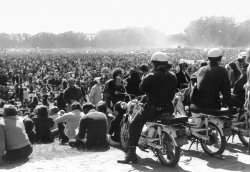
- Forest Brook: 1956
- ... the fire kind. No duck, no cover - and this just north of San Francisco, with its own battery of Nike missiles by the Golden Gate - in plain ... Posted by Dave - 02/14/2013 - 7:14am -
![Forest Brook: 1956 November 8, 1956. "Forest Brook Elementary School, Hauppauge, Long Island. Classroom and teacher." For those of a certain demographic, this may strike a chord. Large-format negative by Gottscho-Schleisner. View full size.
We never did that.I grew up in the suburbs around Akron, Ohio, and we never had a bomb drill or duck-and-cover drill ever. All of my peers that grew up in other places had those drills, which has led me to a couple of possible theories. One, that we had some sort of pacifists in our local administration that refused to take part in the Cold War(unlikely). Or two, that we were so close to potential industrial targets that there was simply no point in hoping for survival... Better to go out in the first flash.
[Never had them in my grade school years 1952-1960 in Larkspur, California, either, nor was I aware at the time that they were going on anywhere. -tterrace]
Lighting fixturesWe had very similar fixtures in my Elementary School about ten years after this, ours had a large bulb with the bottom painted silver sticking through the center though.
They were probably ancient even in 1966.
X marks the spotI'm not sure if it looked that way in 1956, but Forest Brook today has a strange shape, what you might get if Picasso or Dali had been asked to draw the letter X.
Hauppague today is a densely populated community, home to most of Suffolk County's government (though Riverhead is the actual county seat) and a huge industrial park, but back in 1956 it was on the frontier of suburbanization. I wouldn't be surprised if some of the students in this picture were the children of farmers.
You will not leave this house dressed like thatIt would be three years before I entered first grade about 20 miles west of Hauppauge. The New York City Board of Education had a much less relaxed dress code. Boys from first grade on had to wear ties. Jeans and sneakers were not permitted. On school assembly day everyone was required to wear a white shirt or blouse and the boys had to wear red ties. Of course by the time we were graduating from high school there were still strict dress standards, but they only applied to the teachers.
Smelementary SchoolThose wooden desks were washed and cleaned before classes three months ago, and the floors are waxed weekly.
All the girls are in skirts or dresses, and the boys are well groomed and always polite. After all, no one wants to get called down to the school office!
Plus, there's a great lineup of cars out the window, in case a little daydreaming is in order, but only for a few seconds at a time. By the way, you can smell today's newfangled hot lunch almost ready to serve, down the hall.
Let there be photonsMy elementary school (Horace Mann in Burbank, Calif.) had the same light fixtures, although we had four to a room. Each contained one ≈500 watt bulb; the bottom of the bulb was obscured by a silver coating. When a bulb was nearing the end of its service life, it would usually emit a high-pitched squeal. The teacher would then cycle the light switch off and on several times, killing the bulb and throttling the distracting squeal.
Reading MaterialMost of the children have notebooks, many children seem to have the Spell and Write workbook, and the young man in the lower left (just behind the girl in the foreground) has the Air Raid Instruction booklet on his desk.
My First Year of School1956 was my first year of school in Houston. Would have loved to have been able to wear blue jeans and shirt tails out but HISD rules at the time (and almost all the way through my HS years) said no blue jeans, no t-shirts, no shirt tails out for boys and skirts/dresses only for girls.
Hard to believe especially since the schools weren't air conditioned in HISD except for offices and a few other classrooms (science for one)until after I graduated in 1968.
No duck and cover drills for us until the Cuban missile crisis when we were told Houston would be a first strike target due the refineries throughout the Houston area. We had an air raid siren right next to the window in my 5th grade class that went off each Friday at noon. I also thought to myself that if the Russians were smart they would attack at noon on Friday!
Star pupils or problem children?Teacher has all that space in front of the classroom for her desk but it's right up close to those pupils at the far end of the classroom. Even with the photographer present, the kids appear to be gazing out the window. Maybe she needed to be that close to keep their attention for any length of time. I wonder if modern medicine is overused in favor of such simple solutions.
Maybe I'll send the first grade picture (1960) from my Catholic school in New Jersey. It's a bright, clean classroom like the one shown here but it's packed tight with baby boomers, all in navy blue and white uniforms, with Sister in her black and white habit up front.
1956 RebelAlright, who's the non-conformist on staff who just had to park facing the wrong way?
Sturdy Desks and the "Good Old Days"Those sturdy desks are perfect for the inevitable "Flash Drills" of the era, in which the principal would come into the room unannounced and write "FLASH" on the blackboard, causing all of us students to "duck and cover" to avoid instant nuclear incineration. I'm not sure how much good it would have done in a real attack, but it was the only tool in the drawer.
Also, I'm surprised the windows don't have the standard heavy blackout curtains, which were handy not only for viewing nmovies but to keep enemy bombers from spotting stray lights at night.
And a decade laterI started public school a decade later, in a building constructed in 1961. And it was exactly like this, light fixtures, desks, and all. Most of the teachers were young then (and exactly one man, who I got in fifth grade) but I started out with Mrs. Lord, the white-haired wife of the principal, who could have stepped out of any 1910 school administrator picture with naught more than a change of collar. However in my day the fellow with the open shirt front there would have been made to neaten himself up.
Beautiful Schools but the Russians are coming!I began my second semester of kindergarden in January of 1953 in newly built grade school on the west side of Detroit. We immediately began having fire and air raid drills. For air raids we descended into the basement of the school which was actually the main tunnel of the air circulation system. Some times when we went down the stairs during a drill, the big fan would still be rotating after being shut down. We had to sit along the walls and cover our heads. To condition us further the lights would be turned off for a short period of time. I switched to a newly built parochial grade school for the fourth grade on. No basement, so we sat in the main hallway between the class rooms and covered our heads. Both schools had class rooms identical to Forest Brook. To add to the tension, the nearby Rouge Park had a Nike missile battery. The missiles were normally hidden behind a high earth berm, but they were visible when frequently pointed skyward for testing. The AM radio frequencies of 640 and 1240 were permanently etched into our memory.
DrillsI'm exactly the right age for these memories, but except for a few very early instances that were termed "air raid," all our drills were of the fire kind. No duck, no cover - and this just north of San Francisco, with its own battery of Nike missiles by the Golden Gate - in plain view if you took a spin along the Marin Headlands. We all just marched outside. The only time we had to put our practice to use was for a 1957 earthquake centered just south of SF but sharp enough in Larkspur to get us squealing in our fifth grade classroom before the alarm sounded and we made our orderly exit.
"Silver Tooth"I was in the ninth grade in fall of 56. All of the new schools I attended in the late 40's and 50's had those windows and the 9 inch floor tiles. I believe the teacher's desk was in that position only for this pic. One memory came to me in a flash when I saw the tiles. In the 4th grade on the last day of school as I was swinging between desks I did a face plant on the green floor tiles. The impact broke off two of my front teeth below the nerves and the family dentist fixed them with silver caps that stayed that way until I turned 21.
Blue Jeans?I was in 5th grade at the time, in a far western suburb of Chicago. What I remember was the enormous spending on shiny new schools back then. My mom was a teacher, back when teaching was a respected profession, teachers were proud of what they did for a living and grateful for the $6,000 a year they were paid.
That and the rule against blue jeans. Strictly verboten in my school system. They looked "hoo-dy", pronounced with "hoo" as the first syllable, and were a a well known precursor for the dreaded juvenile delinquency during adolescence and a life of crime and depravity later on. Without that rule, thank goodness and a vigilant school board, I probably would have a criminal record by now.
Good Ol' '56I was in third grade in Hempstead, Long Island then. Ike was president and the world 'champeen' Brooklyn Dodgers would win another pennant only to lose once more to the Yanks. Anybody who wore dungarees (as jeans were called then) in my school district would have been sent home to change to proper attire and an open shirt would catch you a stiff reprimand. Nobody knew what a school bus was and schools were not in the restaurant business for anybody. There was a lot to like about those days.
Fond MemoriesI was in 1st grade at that time and our classroom in suburban Chicago looked very much like this one. Someone mentioned getting called down to the office. There was nothing worse than hearing your name on the PA system to report to the principal. Every kid in school knew you were probably in deep doo doo. As for the non-conformist staff member who backed into his spot, these types have always been around and still are today. They'd rather waste extra time and endure the hassle of backing into a parking spot just so they can pull out with ease at the end of the day. Never understood that logic.
The Joys of childhoodI would have been 9 years old when this photo was taken. I was attending "Summer Avenue School" at that time. It was an old three story brick building. We had the kind of desks that bolted to the floor so they couldn't be moved even if you wanted to do so. The seat was actually part of the desk behind you and folded up automatically when you stood up. The top of the desk was hinged at the front so that you could lift it up and put you books and such inside. Oh Yes, they had the obligatory inkwell hole in them as well, but never any ink.
Summer Avenue School still stands but is now known as Roberto Clemente Elementary School.
The desksStarting I guess in the late 40s that blonde style of wood came very much into vogue for furniture. Notice, they're the first generation of school desk withOUT a hole for an inkwell. We had ball point pens by then, no more dipping a nub into india ink. And no more opportunities for dunking the pigtail of the little girl in front of you into the ink!
The furthest cornersAh, those desks. In the later grades of elementary school we ate our lunches in the classroom, and the kid in front of me used to stuff the parts of his lunch he didn’t want into the deepest recesses, behind books and other trash. It got very ripe, and one day the teacher followed her nose to Robert G.’s desk and made him excavate the smelly mess. I will leave the rest to everyone’s imaginations.
4th grade for meDecatur Street elementary. I think the building was probably built at the turn of the last century. And probably the teachers. We had the well worn student desks that you find in the antique shops now for a pretty penny. The one with the ink well and indentation for a pencil with the seat back and foldup seat on the front of your desk. We had 12' ceilings, oiled wood floors that the janitor put sawdust down on daily to use his pushbroom on, kept the dust down.
Old School, New SchoolI started the first grade in 1954 in rural Kansas. We were in a building that had been built in 1911 and only housed six grades. The 7th and 8th grades were in the high school. The bathrooms, the lunchroom, and the art room were all in the basement, and we had music in a one-teacher school building that had been moved into town and put behind the school. The 1911 building was probably a horrible firetrap, although there was a metal fire escape on the back from the second floor down. The district built a new school in 1956, and we moved in in February 1957, when I was in the third grade. It looked much like the one in the photo, except that we had metal desks. No dress code--nearly all the boys wore jeans. That 1956 building is still in use, along with the 1923 high school. Of ocurse, they house far fewer kids than they did then.
Several years laterI was attending a Catholic school in a much older building further west on Long Island -- still vividly remember our "duck & cover" drills as I was the smart-alack who asked how a wooden desk would keep us from burning to a cinder.
As for the cafeteria, no hot lunch then; if you forgot your brown bag (no lunch money; you were not permitted to leave the premises) you might have been lucky enough to be escorted across the street to the convent for a PB&J sandwich.
The uniforms were ghastly -- white shirt, dark maroon tie with the school shield on it, and dark grey slacks with black piping down the outside seam. Girls wore a white blouse with a snap tie, grey plaid skirt (that was always rolled up at the waist after leaving the house, and a matching bolero. Once out of sixth grade boys wore a blue plaid tie & girls could wear a -- *gasp* -- blouse of color.
Reminds me of another picture here of young girls wearing skirts in the dead of winter; evil little Catholic boys that we were, we'd spend the lunch hour in the schoolyard assaulting the bare-legged victims by snapping rubber-bands on their frozen legs.
Not non-conformism. Safety!I've worked at a school for years and even though I'm not much of a rebel, I've always backed into the parking space. The logic is simple: you have to back up when you arrive or when you leave, and it's safer to back *in* to a space when there are few or no children around (an hour or two before school starts) than to back *out* of a space when children are running all around at the end of the school day (of course, one should triple-check either time). I often back into shopping center parking spaces using the same reasoning: if there's no one around when I arrive, it's safer to back up then than later when there might be a lot of people about. I knew a man many years ago who fatally backed over his 4-year-old daughter in their driveway and that tragedy changed my thinking on this permanently.
Reminds me of...Sutton Elementary School, southwest Houston, 1971 to 1973. The building was built in the late 50s and had those same big windows, but by that time we had the one piece metal desks with the big opening beneath for your books.
Few years laterI was in the first grade in a Catholic school in NYC. We had fire drills but no under the desk kiss your butt goodbye stuff. Nuns ruled the roost in those days. Midget Gestapo agents all in black with a yardstick bigger than them which was used to get you back in line if you misbehaved. I remember the first day of 2nd grade while us kids were waiting for school to open and my mom approached me to wipe my nose and the nun smacked her hand saying "he belongs to us now!" Ah memories...
Patty Duke, Ben Gazzara, Gene Hackman were some of the actors who lived in the area, Kips Bay, and might have even attended my school at one time.
"Snaggletooth"I can sympathize with jimmylee42. I broke a front tooth in much the same way at my school in the fourth grade. It was the winter of '63-'64.
When the weather was exceptionally cold, they would open the gym for the early kids to come inside before classes started. Although the details are vague now, someone said I was tripped by a bully while I was running around. In a family of four siblings my folks couldn't afford to get my missing tooth capped for years. So one of my nicknames throughout grade school was "Snaggletooth"... not one of my fonder memories. I finally got a white tooth cap just before I started senior high after we moved to Florida.
I wonder how my Alabama classmates would remember me now?
Yes, the Memories!I would have been right in this age range, near as I can tell from looking at the kids. That would have made it my first year out of parochial school, escaped from 4th grade under the rule(r)Sister Rita Jean, she who was Evil Incarnate.
Best memory was teacher telling me, "David! Stop moving your desk around. It makes me think we're having an earthqu... Everyone - outside!!"
DaveB
WonderfulGrade school in Alexandria, Louisiana. Very familiar classrooms, with the good Nun up front to keep [or try to keep] us on the right path.
Bayou View SchoolThis reminds me of Mrs Powell's 2nd grade class at Bayou View School in Gulfport, Ms, c.1955.
Fast ForwardTwenty years later I attended a school built in the early 1940s. This reminds me of those old classrooms in some respects with the desks all lined up in rows, large windows and undoubtedly a large slate chalkboard just out of view. I notice that the teacher's chair is a sturdy wooden straight back chair - no comfortable office chairs here! Also, only a two drawer filing cabinet? I don't think I've ever seen one that small in a classroom. I teach school now and while this brings back memories (even the light fixtures), it's amazingly different today.
Green ThumbThe teacher has quite a spartan setup, but I love the line of flowers along the windowsill! What a lovely touch that would be in a classroom.
This was a fun photo and I enjoyed the comments. My parents were born in 1954 and I really like seeing and reading about what that might have been like.
I grew up in that town!I didn't go to this school, but grew up in Smithtown--where this school actually was; not Hauppauge. I was in elementary from 1990-1995, when times were much different. As a teacher I love seeing how it was then.
Love this photo but makes me sadIf I could push a button and go back in time and be someone someplace in the past, I'd be on my way to being one of the kids in that classroom. This is public school education when it was about education.
(The Gallery, Education, Schools, Gottscho-Schleisner, Kids)](https://www.shorpy.com/files/images/SHORPY_5a24730u.thumbnail.jpg)
- Nash Palace: 1927
- San Francisco circa 1927. "Nash sedan at Palace of Fine Arts." Topping the Shorpy ... his eponymous fitting until January 1929.
Why San Francisco? After years of observing Shorpy, I'm beginning to think that ... Posted by Dave - 03/04/2018 - 5:26pm -
![Nash Palace: 1927 San Francisco circa 1927. "Nash sedan at Palace of Fine Arts." Topping the Shorpy Shortlist of Chic Chauffeurs. Photo by Christopher Helin. View full size.
Metal platesWhat was the purpose of those plates beneath each door?
[Kick plates for getting the schmutz off your shoes. - Dave]
Pre-Zerk NashThe rear leaf spring front shackle grease fitting visible through the access hole in the rear door kick plate is probably a flat top Alemite, as Oscar U. Zerk wouldn't get around to patenting his eponymous fitting until January 1929.
Why San Francisco?After years of observing Shorpy, I'm beginning to think that back in the day, new cars were only photographed in San Francisco.
TiresThe rear tires almost look like radials, The fronts have a different tread but even those seem to wrap around a bit. Not the flat G78-15's I had on cars right up into the 80's. That's a lot of car
(The Gallery, Cars, Trucks, Buses, Chris Helin, San Francisco)](https://www.shorpy.com/files/images/SHORPY-1253.thumbnail.jpg)
- Pontiac Nation: 1928
- ... no doubt bring a tear to Chief Pontiac's eye.
San Francisco in 1928. "Scouts in Indian costume with Pontiac autos." Junior G-men ... Posted by Dave - 10/27/2019 - 3:25pm -
![Pontiac Nation: 1928 A scene that would no doubt bring a tear to Chief Pontiac's eye.
San Francisco in 1928. "Scouts in Indian costume with Pontiac autos." Junior G-men by the looks of it. 8x10 inch nitrate negative. View full size.
Why all the San Francisco Car Pix?How does Shorpy come by so many car pictures from the San Francisco Bay Area?
[He bought them from the estate of a lady who collected them. - Dave]
Indian trade blanketsThose costumed Scouts are sporting Indian trade blankets made by Pendleton woolen mills in Oregon (the two on the right are definitely Pendleton patterns from that era) and others. They were traded to the Indians in early days, but Pendleton kept making them to the present day. The older ones, like these, are pretty valuable. I have one from 1930 with the original tag and a hand sewn tag with the owner's name, who apparently took it to camp or college.
PontiacsWow! Can you imagine the outrage today over something like this? And we thought the Washington Redskins stirred it up.
Companion CarThe first Pontiacs were built in 1926, as a "companion make" to the Oakland automobile. Oaklands were built from 1901 to 1931, until Pontiacs began to outsell them by a wide margin, then GM phased the Oakland out in favor of the Pontiac. Of course, now the PMD itself is now history.
Probably Not Boy ScoutsJudging from the "G" on the hats and the triangular shaped patch on one boy's shoulder, my guess is that these are Indian Guides, an organization sponsored by the YMCA. The organization still exists, but within the last few years has shed the name and is now known as "Adventure Guides."
[The triangle is similar to the Scouts' current "First Aider" badge. We also have a Cub Scouts insignia. - Dave]
Order of the ArrowThey are definitely Boy Scouts, just look at the uniforms. The older guys are likely members of Order of the Arrow, which is still functioning. I was made a member when I was a Scoutmaster in 1983.
(The Gallery, Boy Scouts, Cars, Trucks, Buses, Native Americans, San Francisco)](https://www.shorpy.com/files/images/SHORPY-195-01.thumbnail.jpg)
- Blazing Buick: 1922
- San Francisco, 1922. "Buick roadster at California Street firehouse." If we ride ... began his rise to success in the aftermath of the 1906 San Francisco earthquake. His Buick dealership had some of the few functioning ... Posted by Dave - 09/25/2014 - 2:57pm -
![Blazing Buick: 1922 San Francisco, 1922. "Buick roadster at California Street firehouse." If we ride along, can we ring the bell? 5x7 glassneg by Christopher Helin. View full size.
Factory equipmentThis model comes with a door-dinger installed. Why wait for others when you can do it yourself?
World's RecordSmallest official Logo on any municipal vehicle, bar none.
From Charles Howard?Seabiscuit's owner began his rise to success in the aftermath of the 1906 San Francisco earthquake. His Buick dealership had some of the few functioning motor vehicles available after the quake, and he loaned them to the city. His generous action also made the public aware of the benefits of his motorcars. He further boosted sales by accepting horses as trade-ins. It's said that's where he learned to value, and eventually race them. Did the city government show its thanks by buying Buicks?
I Am RemindedIn British films of the '40s and '50s, police cars zoomed through the streets in pursuit of malefactors while clearing traffic from their paths by means of little bells that made my first tricycle's seem cacophonous by comparison.
Was the pursuit of justice ever really such a genteel affair?
San Francisco firefightersCould have spent a little less time polishing their pumpers and turned their attention to the door of the captain's Buick.
2150 California StreetIt looks like San Francisco still maintains a fire station at that address, but the original we only catch a glimpse of in this photo was amazing.
I'm actually eagerly hoping Shorpy has a better shot than the one I was able to find of the old building. (More photos here.)
It got uglyThe firehouse as it looks today at 2158 California Street.
Where'd he come from?I didn't even realize there was someone in the driver's seat until I noticed the hand on the steering wheel.
[He probably didn't see you, either. - Dave]
(The Gallery, Cars, Trucks, Buses, Chris Helin, San Francisco)](https://www.shorpy.com/files/images/SHORPY-GN-004A.thumbnail.jpg)
- Belles-Motors: 1924
- San Francisco circa 1924. "Buick sedan at Lafayette Park -- costumes." If only some ... that fur is sticking to the seats.
Must Be Summer in San Francisco The ladies are all bundled up.
Tires Love the narrow ... Posted by Dave - 10/26/2015 - 2:28pm -
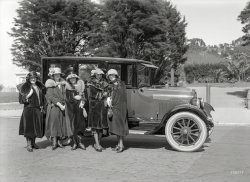
- Offroaders: 1919
- San Francisco circa 1919. "Franklin touring car." Some of the ladies last glimpsed ... Dual upper and lower suspension leaf springs.
The San Francisco Scuff As noted before, the characteristic scuff of the right ... Posted by Dave - 01/18/2017 - 1:05pm -
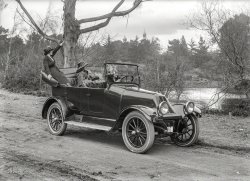
- Amex: 1910
- ...
The Magic 8 Ball says Los Angeles.
My bet is on San Francisco This is obviously just a local branch office, and a window on an ... Posted by Dave - 08/02/2012 - 5:23pm -
![Amex: 1910 Circa 1910. "American Express Co., Main and Sixth." Just steps away from the Aseptic Barber Shop. Who can tell us what city we're in? View full size.
Pacific Electric Building, Los AngelesThis is the Pacific Electric Building (or Huntington Building) at 6th and Main in Los Angeles, California. You can see intertwined Ps and Es in the column capitals at the cornice.
And, amazingly enough, still there!
Main & SixthIt's Sixth Street, not State, but I have no idea what city.
On state streetthat great street, I just want to say, they do things they don't do on Broadway. Chicago?
[I goofed in typing "State." Should have been "Sixth." - Dave]
It's the Huntington BuildingIt's the Huntington Building in Los Angeles. "W.M.Garland & Company" was the clue."
Pacific Power and LightPortland?
Amex 1910 locationThe lampposts ("5-Globe Llewelin") indicate downtown L.A., unless the design was used elsewhere. But I don't believe so.
West CoastI would guess Los Angeles as there is a Pacific Light and Power sign on one of the windows in the building.
Dual gauge in L.A.It's Los Angeles. The tipoff (for me at least) is the dual-gauge streetcar track -- 3'6" for the city streetcars of the Los Angeles Railway; standard gauge for the interurbans of the Pacific Electric.
I'm going to guess Los AngelesWe're on S. Main Street.
Pacific Light and Power Company in one of the windows is a clue we're on the west coast.
The real clue are the offices of W. M. Garland Company Real Estate. Mr. Garland was a commercial developer in Los Angeles. He was instrumental in bringing the Olympics to Los Angeles in 1932.
That's my final answer.
Los AngelesI believe this is the old Pacific Electric building on Sixth and Main.
http://en.wikipedia.org/wiki/Pacific_Electric_Building
In Los AngelesThis is the Pacific Electric Building in Los Angeles.
Lazy AnswerMy limited research leads me to guess that the city we're looking for is Kingston, New York.
Still There Too!Here it is today.
City Of AngelsDowntown Los Angeles. The actual building was called the Pacific Electric Building.
AlohaI'm going to guess Honolulu based on the "Pacific Power and Light" sign in an upper window.
That Toddling TownI gotta say it's Chicago.
InterurbanPacific Electric Building in Los Angeles, CA
American ExpressThat building, I believe, is the one on Broadway in NYC.
Los AngelesI think this is L.A.
Could it besunny Los Angeles?
The Magic 8 Ball saysLos Angeles.
My bet is on San FranciscoThis is obviously just a local branch office, and a window on an upper floor says "Pacific". And, the number of streetcars.
Los AngelesCorner of W. Sixth and S. Main, Los Angeles. All three buildings still there.
We are in Los AngelesSixth and Main, Los Angeles. That is the Edendale streetcar line.
Los AngelesThe building is the Pacific Electric headquarters at 6th and Main, in Los Angeles. More here.
Sitting downBet there isn't a bloke sitting on a stool in the intersection now.
More importantWhy is there a man who appears to be holding a newspaper sitting on a chair in the middle of the street? Perhaps the officer is telling him to "move along now, nothing to see here."
Trolleys left their markThe attachments where the various wires and cable were are still visible on the building.
View Larger Map
Follow the trolley toEdendale.
AlwaysWonderful to know where you are! But who is that sitting on a stool, in the middle of the interesection, next to the policeman? And why?
Pacific Electric Railway Terminal
The National Magazine, 1908
The Huntington Interests
The lines operated by the Los Angeles Railway Company, the Pacific Electric, the Los Angeles Inter-Urban Railway Company, the Los Angeles & Redondo Railway Company, The San Bernardino Valley Traction Company and the Riverside & Arlington Railway Company, which comprise the Huntington system, is undoubtedly the greatest system of street and inter-urban railways in the world. It consists of over 500 miles of standard gauge line, reaching from Alpine (Mount Lowe), a mile above the sea, to the south coast ocean resorts, and penetrates all the valleys in the beautiful country adjacent to Los Angeles. …
The Pacific Electric Railway was the name adopted by the corporation managing the suburban electric lines of the Huntington system, Mr. Huntington having acquired the line to Pasadena and outlining the plan for an extensive system of suburban railways reaching out from Los Angeles in every direction. Since then there have been completed electric railroads to practically every city and town of importance in Southern California and to the thriving beach resorts tributary to Los Angeles as a center. …
One of the most enduring monuments to his public spirit and enterprise is the mammoth Pacific Electric Building of Los Angeles, a building of nine stories, with eleven acres of floor space and which is the terminal station for the wonderfully perfect inter-urban system. This is the largest structure of its kind west of Chicago, and was completed in December, 1904.
The American Architect and Building News, 1908
The Pacific Electric Building, and the
Jonathan Club Roof Garden, Los Angles, Cal.
The rooms and roof garden of the Jonathan Club, on the upper stories of the Pacific Electric Building, at Los Angeles, were an afterthought.
At the time the external character of the building was determined by Mr. Thornton Fitzhugh, the architect, the contracts let and the construction work well advanced, no thought had been given to the adaptation of the upper floors for club purposes. This problem was therefore a most difficult one, not only because the changes involved were many and complicated, but owing to official dictation and limitations imposed, the result is one in many respects quite at variance with what would have been accomplished had the architect been allowed freer rein in his work. None the less the Pacific Electric Building presents characteristics that would entitle it to some measure of recognition if built in the largest cities. Its proportions for a city the size of Los Angeles are unusual and its equipment such as will meet every condition of a first-class office building.
The building stands on a plot 285x211 feet, and is nine stories high. The total floor space is more than twelve acres, and exceeds in area the Broad Exchange Building in New York, which is 21 stories high. The structure was erected for the Pacific Electric Railway Co.
The basement has a clear floor space of 58,000 feet and is designed for use as a freight depot.
The main floor ceiling is thirty feet high, supported by cement columns. Through an opening sixty feet high, spanned by a cement girder eight feet deep, the cars enter the building.
The upper stories from the second to the sixth inclusive are devoted to offices. There are ninety-nine offices on each floor, or a total of 594 in all.
No office is less than twenty by fifteen feet, and they range in size to a maximum of sixty by thirty feet.
All three still there!the building on the right looked very modern in 1910, all simple and light.
Another vote for LAThe streetcar on the left side of the image says, "Edendale," which was a neighborhood in old Los Angeles.
Imagine an LA with ..."completed electric railroads to practically every city and town of importance in Southern California and to the thriving beach resorts." I'll think of that during my commute.
Familiar!It looks very much the same today, though I doubt the chap on the stool in the middle of Main Street would find his perch as comfortable today.
Before the credit cardWhat was American Express' main line of business?
[Express is short for "express mail." Express companies like Adams Express and American Express were businesses similar to UPS or FedEx, relying mostly on the railroads for speedy delivery. American Express specialized in services to travelers -- travelers checks and money orders. The window gives some clues. - Dave]
The loneliest man in the worldI love it when a shot of an old building includes a person looking out a window. This one's a classic.
You should see insideI worked on a couple of movies in the late '90s inside the abandoned Pacific Electric building. What an amazing space. I wandered all through the building and stumbled into what I was told was Huntington's private office -- awesome, massive, with unbelievable marble stairways. In "Gang Related" worked on one scene right around where the streetcar is shown here coming out of the garage. In the scene was Tupac Shakur, who appeared to be somewhat inebriated. It wasn't too much longer after that that he was murdered in Las Vegas.
Yay LAIt's great to see a photograph of Los Angeles on Shorpy. I will have to take a look at this spot this weekend and stand at this corner. There's a great restaurant down the street on 4th and Main called Pete's with great Mac and Cheese.
No Traffic ControlWow, no stop sign or anything. I also like the seat on the front of the trolley on Sixth. Does one pay extra to be out in front?
610 South MainIt is indeed the PE Building, later the Southern Pacific’s general offices in Los Angeles. I worked there in the late 1970's and early 1980's when the Red Cars were long gone and the street-level station was turned into a parking lot. Our disptaching office controlled traffic betweeb Yuma, AZ and Fresno /San Luis Obispo, CA. Downstairs it was interesting to park one's car next to marble-covered columns. Working rotating shifts I sometimes had to step over a local citizen or two sleeping on the sidewalk.
The building closest to the viewer on the left was the Santa Fe's offices and across the street out of view to the right was the Continental Trailways bus depot. The top floors of the PE building housed a handsome two-storey atrium - perhaps Mr Huntingdon's offices. We had a “Watch Inspector” (a man who sold and serviced approved railroad timepieces) in the building and I bought a Ball Trainmaster wristwatch from him for about $120. Years later it cost that much just to have it cleaned. Understand the neighborhood is much nicer now and this building is a condominium.
StillWanna know what's up with the seated person in the middle of the intersection!
(The Gallery, DPC, Los Angeles, Streetcars)](https://www.shorpy.com/files/images/4a25789a.thumbnail.jpg)
- Ford vs. Chevy: 1958
- ... vs. Chevy, vintage 1957, played out under an expressway in San Francisco circa 1958. 4x5 inch News Archive negative. View full size.
A ... Posted by Dave - 10/28/2015 - 2:23pm -
![Ford vs. Chevy: 1958 The age-old battle of Ford vs. Chevy, vintage 1957, played out under an expressway in San Francisco circa 1958. 4x5 inch News Archive negative. View full size.
A firstThe first of these crash pictures where the cars aren't totaled.
Gotta be a good $50 or $60 worth of damage though.
Pretty sure this is San FranciscoUnder the Bay Bridge approach. The building advertising Copper Works is still there, and so is the advertising. Corner of Fremont and Folsom.
[Yep, although that's the now-demolished Embarcadero Freeway. Just last Thursday I took this picture of the O'Donnell Copper Works Building. An architectural firm has occupied it for several years, but has kept the original weathered signage. -tterrace]
'56, '57, '58Chrysler, Pontiac, Ford in left background. Neither car looks very pristine for only a year old and coincidentally they are both the mid-level trim models.
A Good DealI'll take all-day parking for 75 cents any day!
Parking? Lots.The thing that attracted my attention in the photo was 75 cents for all day parking! I did a quick search to find the cost of parking all day in San Francisco today, and discovered that the closest lot to the corner of Folsom and Fremont, near where the photo was taken, costs $30 for all-day parking. Based on normal inflation of 1958 dollars, the same parking today should cost $6.20. But nothing about San Francisco is normal! (Some things just defy inflation, don't they?)
A little revenge?Ford outsold Chevy in 1957.
(The Gallery, Cars, Trucks, Buses, News Photo Archive, Signal 30)](https://www.shorpy.com/files/images/SHORPY-739.thumbnail.jpg)























